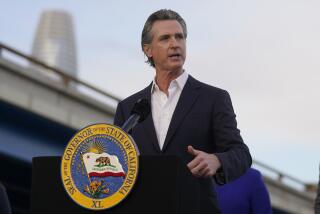Fuel is cheap, but we’re still saving it
- Share via
Not since January 2005 have California drivers had it this good: The state’s average retail price for gasoline tumbled 15.7 cents in the last week to puncture the $2-a-gallon barrier, the Energy Department said Monday.
But many motorists -- convinced that the economy was a mess and fuel costs could leap again with little warning -- were still clinging to behavior acquired when pump prices hit record highs during the summer.
In past years, Americans always returned to their old driving habits, even when prices settled higher than they had been before. But the last cost increase reached intolerably high levels of $4.11 a gallon nationally and nearly $4.60 a gallon in California, analysts said. That occurred as home values, retirement accounts and the stock market were crashing.
“The effects of these influences on income and wealth have overwhelmed the impact of these fuel price drops,” said Energy Department economist Neil Gamson. “And gasoline demand will continue to fall. It will be lower in 2009 than it was this year.”
In California, the nation’s biggest fuel market, gasoline consumption was down 8.3% and diesel use was down 14.4% in August, the most recent month for which data were available, from year-earlier levels, the state Board of Equalization said Monday.
In addition to sluggish demand, falling oil prices, which are down more than 60% from the July peak above $145 a barrel, are contributing to lower gas prices.
Oil tanked Monday after a weekend in which the Organization of the Petroleum Exporting Countries looked anything but unified in deciding not to cut production, and the stock market plunged on word from the National Bureau of Economic Research that the nation was in the midst of its longest contraction in 26 years.
Light sweet crude for January delivery dropped $5.15 a barrel, or 9.5%, to close at $49.28.
The market didn’t really believe that OPEC members would be able to agree on cutting more production, and the news that the nation was in a recession wasn’t exactly a surprise, said John Kingston, global director of oil at Platts, which provides information on the energy and metals markets for clients in 150 countries.
“If you’re looking for something bullish about oil, you’ll be looking far and wide,” Kingston said.
Lower gasoline prices felt relatively insignificant to many consumers, even in a week when the average price of a gallon of self-serve regular gasoline in California fell to $1.955 and the national average declined 8.1 cents to $1.811, the lowest in almost four years.
In the midst of the gloomy economic news, Rosalyn Mitchell wasn’t feeling much joy. The software saleswoman was topping off her rental car at an Arco station near Los Angeles International Airport for $1.79 a gallon before returning it and flying back to Phoenix.
“It’s like this momentary good feeling in the middle of a general sense that we’re all doomed,” she said.
Maninda Khalsa of Folsom, Calif., felt much the same way. The Khalsa household, which includes his wife, his mother and two children, wasn’t planning to ease up on the new efficiency the family had achieved in running errands.
The Khalsas previously would hop into the family’s 2000 Toyota Corolla to do a single errand. Now they wait until they have accumulated as many as two dozen tasks before they take a single drive to handle all of them.
“I think there is a general realization now that these low prices are not going to last,” Khalsa said. “I don’t see myself going back to my old habits when what we are doing now leaves money in our pockets.”
In fact, there is a sense that many Americans haven’t gotten over last summer’s record gas prices and are feeling insecure about their financial situations.
A weekly online poll by GasBuddy.com, a website that posts gas prices spotted by a small army of members, found that about 74% of the 16,513 respondents to the current survey fear that oil prices will hit $100 a barrel again in less than two years, and 52% think it will reach that price in less than 12 months.
Another recent poll of more than 39,000 members showed that 54% were still limiting their driving and combining multiple errands into single trips. An additional 16% said they had reduced their driving speeds and weren’t planning to speed up again. Only 18% said they hadn’t changed their driving habits to save fuel, and 2% said they had gone back to their old ways of driving.
“Under normal market conditions, all of this effort to conserve would have been reversed, but people are not feeling secure about their jobs. They aren’t feeling good about their financial situations, and they are saving all of the money they can,” said James Ritterbusch, president of Ritterbusch & Associates, an oil trading advisory firm.
Ritterbusch said he had just spoken to a woman in Minneapolis who said she was riding her motor scooter to work instead of taking her car, in spite of the drop in gasoline prices.
“She just puts on a snowsuit and off she goes,” he said. “If she’s doing that in Minnesota in December, you know a lot of people are doing similar things in places that are a lot warmer.”
--
More to Read
Inside the business of entertainment
The Wide Shot brings you news, analysis and insights on everything from streaming wars to production — and what it all means for the future.
You may occasionally receive promotional content from the Los Angeles Times.







